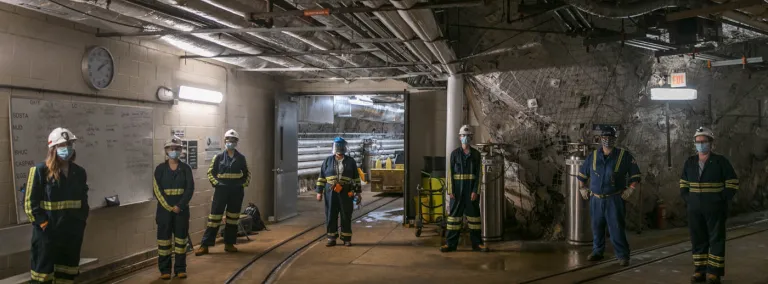Sanford Lab supports undergraduate experiences during COVID-19
In 2020, students gain real-world experience in environments where even experts are reexamining how to move science forward
As viewers clicked the calendar invite to watch Sanford Underground Research Facility’s (Sanford Lab) 2020 Internship Presentations, they might have remembered previous years, when these presentations drew dozens of attendees for a brown bag lunch, cookies and lemonade to celebrate what the summer interns had accomplished.
The virtual presentation included now-familiar audio glitches and occasional screen sharing issues, but as technical hiccups were quickly resolved, viewers saw just what was possible for dedicated students to accomplish at an underground science facility—even one operating during a pandemic.
One student had helped transform a city-wide science festival into an internationally attended virtual event. Another had created resources for area STEM educators preparing for an unprecedented school year. Still others, who had worked underground during the summer, shared photos of far-off drifts where they mapped ventilation trends or gleaming cleanrooms where they helped assemble a dark matter detector.
Gabriel Peters, who studies mechanical engineering at South Dakota State University, spent his summer working with the LUX-ZEPLIN (LZ) experiment on the 4850 Level. During his presentation, he described some of the safety gear he wore each morning while traveling underground: “Hard hat, safety glasses, respirator, gloves, mask, a onesie-jumpsuit-thing… COVID-19 presented challenges to an in-person internship, but Sanford Lab made me feel safe every day that I came to work.”
Whether working primarily from home or onsite, Sanford Lab’s summer interns reflected on how they adapted to a work environment impacted by COVID-19 to gain experience in their field. In August, the interns who worked primarily from home during their internships received a tour of the underground facility.
“During this very challenging time, Sanford Lab remains committed to carrying out our mission to advance science through education and public outreach,” said Mike Headley, executive director of Sanford Lab. “We are grateful to continue offering opportunities to undergraduate students to grow in their diverse fields and to contribute to world-leading science at Sanford Lab.”
In addition to summer interns, seven South Dakota students also participated in Research Experience for Undergraduates (REU), a program funded by a National Science Foundation grant and led by Black Hills State University (BHSU). The program connected seven students from four South Dakota universities with professors who mentored them in undergraduate science research at Sanford Lab.
Brianna Mount of BHSU is the director of the REU Program. Mount said the program gives student researchers opportunities to engage in research related to some of the most important physics experiments of our time—searching for dark matter and investigating properties of the neutrino.
Through REU, Ayla Rodriguez, a physical science and math major at BHSU, worked with Mount in the BHSU Underground Campus low background counting facility. Her work onsite gave her a new perspective on her field of study.
“I think this was the first time I ever fully grasped what we do with low background counting, as well as how many people are involved and the passion and accountability that every person who comes through takes upon themselves,” Rodriguez said.
As a result of COVID-19, some REU students participated solely in online research, coding and data analysis. Sam Schleich, a physics major at South Dakota School of Mines & Technology, was looking forward to the REU program after participating in the Davis-Bahcall Scholars Program in 2019. “I was excited to do hands-on research, but my involvement moved online,” Schleich said. “I'm really grateful, though, that they put in the effort to move it online, rather than fully canceling the program.”
Schleich spent his summer developing a coding simulation to flag false signals in the LZ dark matter detector. He said the program taught him how big science really works: “There's definitely a lot more behind the scenes than I originally thought. It's not just five scientists sitting in a room, coming up with all these ideas. There's a lot of undergraduate and graduate students helping with the smaller details, kind of like I did.”
Replacing lab work with coding. Creating a virtual science festival. Providing virtual support to STEM educators. Wearing a respirator to travel underground. For these 2020 undergraduate students, gaining real-world experience in their fields meant working in an environment where even the experts are reexamining how to move science forward safely and efficiently.
